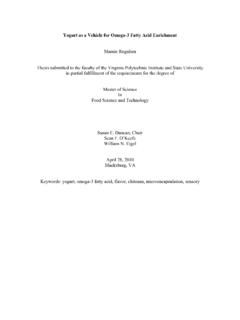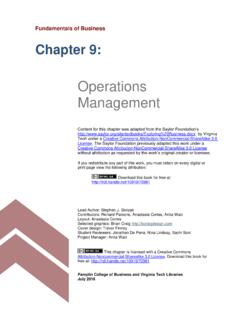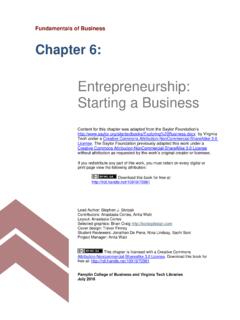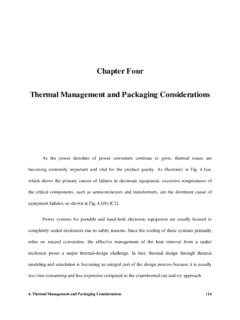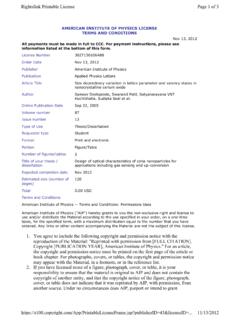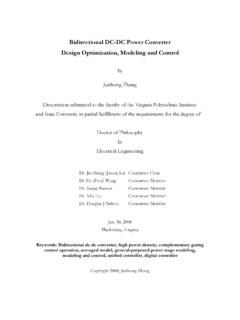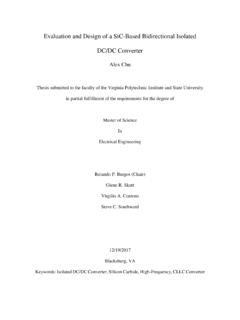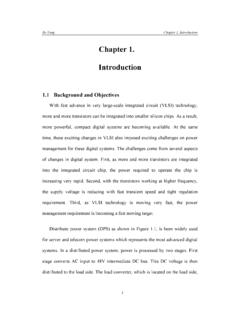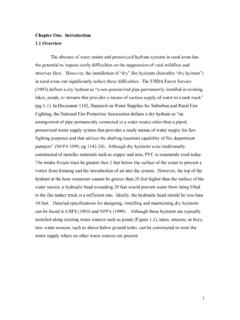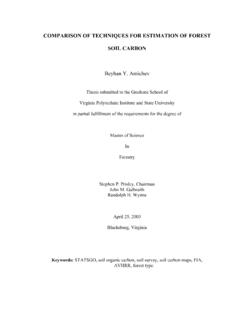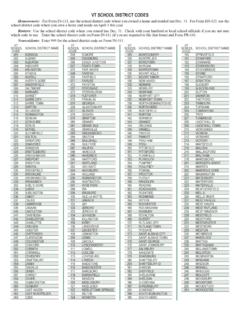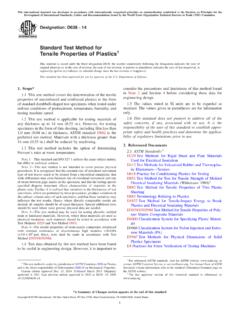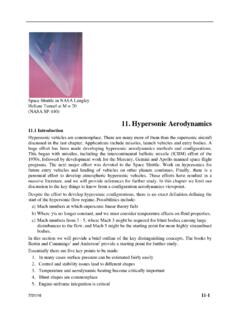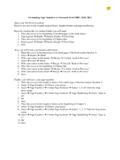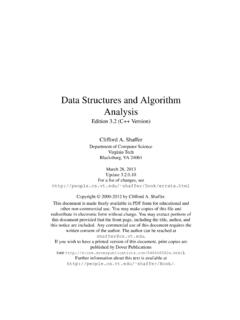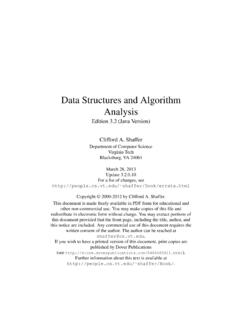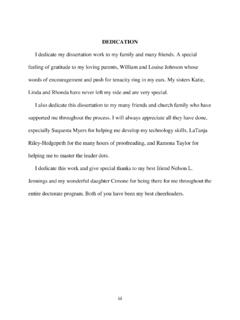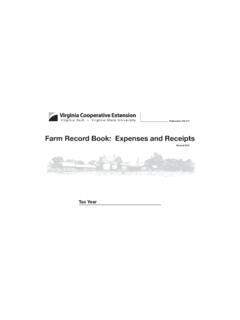Transcription of Mechanical Properties and Durability of ... - Virginia Tech
1 Mechanical Properties AND Durability OF NATURAL RUBBER COMPOUNDS AND COMPOSITES Joseph Thomas South Dissertation submitted to the Faculty of the Virginia Polytechnic Institute and State University in partial fulfillment of the requirements for the degree of Doctor of Philosophy in Materials Engineering Science Kenneth L. Reifsnider, Chair Scott W. Case John J. Lesko Herve Marand Brian J. Love December 14, 2001 Blacksburg, Virginia Keywords: Natural Rubber, Cord-Rubber Composite, Rubber Reversion, Crosslink Copyright 2001, Joseph Thomas South Mechanical Properties AND Durability OF NATURAL RUBBER COMPOUNDS AND COMPOSITES Joseph Thomas South (ABSTRACT) The focus of this research was to investigate the effect of thermal degradation upon the Mechanical Properties of natural rubber compounds and apply those effects to the life prediction of off axis 2-ply cord rubber laminates.
2 The work examined both the quasi-static and dynamic Mechanical Properties of two natural rubber vulcanizates, which had been subjected to isothermal anaerobic aging. Thermal aging was performed on two different natural rubber vulcanizates. The thermal aging was conducted between the temperatures of 80 and 120 C for times ranging from 3 to 24 days. The effect of thermal degradation was measured from the changes in the chemical composition of the vulcanizates as functions of time at temperature. A master curve relationship between the changes in the chemical composition of the vulcanizates due to thermal degradation and their static and dynamic Mechanical Properties has been developed. This relationship allowed for the prediction of the vulcanizate Mechanical Properties after thermal aging.
3 It was found that the Mechanical Properties correlated with the percentage of poly and monosulfidic crosslinks, where in general higher levels of polysulfidic crosslink gave rise to the highest Mechanical Properties . Crack propagation in an aged and unaged natural rubber vulcanizate was measured using a double cantilever beam, DCB. This type of testing arrangement exhibits a plane strain condition and resulted in crack growth rates two orders of magnitude faster than traditional plane stress testing geometries. To validate the DCB specimens, an investigation into the potential cavitation inside the rubber of the DCB specimens was performed. It was found that no cavitation occurred due to the high speed of the fracture.
4 DCB samples were thermally aged to determine the effect of thermal aging upon the crack growth rate. It was found that crack growth rates increase with thermal aging. Life prediction of the aged 2-ply laminates was performed using a finite element analysis. In order to verify the finite element models used in the life prediction, the fatigue failure and crack growth characteristics of off axis 2-ply cord-rubber laminates were examined with a delamination analysis. This analysis allowed for the determination of the modulus of off axis 2-ply laminates in the presence of damage as well as the calculation of the crack growth rates of the laminate. The failure of unaged and thermally aged 2-ply laminates was evaluated and compared to the crack growth rates of thermally aged DCB specimens.
5 The trend due to thermal aging between the two types of testing specimens was consistent. The finite element analysis was sectioned into two approaches: crack initiation and crack propagation. The former utilized a residual strength approach, while the latter applied a fracture mechanics approach. The predicted stress versus cycles, S-N, curves were not in complete agreement with the experimental data. The error between the predicted and the experimental is discussed and future work to correct that error is suggested. While there was not complete agreement between the predicted and the experimental data, this dissertation outlines a comprehensive approach to track the effects of thermal degradation and apply those effects to a real world application.
6 THE ROAD NOT TAKEN Two roads diverged in a yellow wood, And sorry I could not travel both And be one traveler, long I stood And looked down one as far as I could To where it bent in the undergrowth; Then took the other, as just as fair, And having perhaps the better claim, Because it was grassy and wanted wear; Though as for that the passing there Had worn them really about the same, And both that morning equally lay In leaves no step had trodden black. Oh, I kept the first for another day! Yet knowing how way leads on to way, I doubted if I should ever come back. I shall be telling this with a sigh Somewhere ages and ages hence: Two roads diverged in a wood, and I- I took the one less traveled by, And that has made all the difference. Robert Frost, Mountain Interval, 1916 v ACKNOWLEDGMENTS The author would like to thank the following people who have been instrumental in the progression of this dissertation: Larry and Jean South: My parents.
7 Had you not pushed me to better myself and educate myself I would not be here now. Thank you! Keryl Ann Cosenzo: My wife. Your motivation and support are without words. We ve woven our lives together traveling down the same road. Now we are challenged to begin a new road together, may it be the road less traveled. Dr. Kenneth L. Reifsnider for offering me a research position in the Materials Response Group. This research would not have been possible without your support and guidance. Dr. Scott W. Case for your open door policy and the countless times I came to you with a question and was received with a smile and a warm bit of sarcasm. Dr. Jack Lesko for your constant support and critical review of my work. Dr. Herve Marand & Dr.
8 Brian J. Love for their helpful input and advice during the generation of this dissertation. Mac McCord for his help with the experimental testing and the ultrasonic C-Scan. Shelia Collins and Beverly Williams for being the backbone that makes the MRG thrive. It is always the behind the scenes work that fosters success. All the members of the Materials Response Group for their support and help in the analysis. Dr. Allan Gent for his insightful opinion into rubber cavitation. Thomas Fleischman for his invaluable contributions including the fabrication of the DCB specimens, fatigue testing of the aged compounds and the supply of all the compounds tested in the research. vi Dr. Mahmoud Assaad for his assistance in the generation and analysis of the finite element models.
9 Ed Terrill for performing the crosslink analysis on the thermally aged compounds. Mr. David Simmons and the entire ESM Department Machine Shop for their assistance in the cutting and milling of the DCB specimens. Mr. Stephen McCartney for his invaluable assistance with the SEM and TEM. vii TABLE OF CONTENTS LIST OF LIST OF CHAPTER Fatigue of Crack Growth Analysis and Rubber Filler Rubber Aging of Rubber Rubber Molecular Cord Rubber Statement of OF Dynamic Mechanical Differential Scanning Thermogravimetric Transmission Electron Creep Compound Seasonal AGING AND CHEMICAL Thermal Thermal Aging Determination of Crosslink Polysulfidic and Monosulfidic Master Compound Compound Total Crosslink Density Master Soluble Ultimate Compound Compound viii Ultimate Compound Compound Youngs Compound Compound Shear R-Ratio Effect on Fatigue Elevated Temperature Fatigue Thermal Aging
10 Effect on Fatigue Double Cantilever Quasi-Static DCB Single Edge Notch Fatigue of DCB DCB Cavitation at the Crack Molecular Thermal Aging Effects On Crack LAMINATE Fatigue Crack Growth of 2-Ply O Brien Approach: Delamination Growth Analysis 18 Fatigue Crack 18 S-N Curve Unaged 18 2-Ply Laminate Delamination Aged 18 2-Ply Laminate Delamination 45 Fatigue Crack 45 S-N Curve 45 2-Ply Laminate Delamination Crack Residual Strength Failure Calculation of the Number of Cycles for Crack 2-Ply Laminate Crack Growth Laminate 18 2-ply Sources of Error in the 18 FEA ix Experimental Additional Source of 45 2-Ply Sources of Error in the 45 Thermal Mechanical Finite Element Future x LIST OF TABLES Table 2-1 Typical carbon black types and the range of particle sizes for compound A and compound Table 8-1 Values of the Paris-Law
